Posted by: Northwest Eye in General on June 7, 2025
Overview
This article addresses the signs that may indicate Demodex mites are dying, along with their implications for those experiencing related eye conditions. We understand that dealing with these issues can be challenging. Symptoms such as:
- Increased eye irritation
- Flaking skin
- Reduced redness
not only signify the decline of these mites but also reflect the effectiveness of treatment strategies. This is encouraging news as it can lead to improved overall eye health and enhance your well-being. Remember, we are here to help you through this process.
Introduction
In the realm of eye care, we understand that the often-overlooked impact of Demodex mites can be concerning. At Northwest Eye, where over five decades of expertise converge with innovative treatment strategies, we are committed to addressing these worries. These microscopic pests are not just a nuisance; they can lead to a host of eye conditions, including blepharitis, affecting countless individuals across all age groups.
With a focus on personalized care and cutting-edge technology, Northwest Eye stands at the forefront of managing Demodex-related complications. We ensure that patients receive tailored treatment plans that address their unique needs. As awareness grows regarding the symptoms and implications of Demodex infestations, understanding the signs of mite die-off becomes crucial for effective management.
This article delves into the various indicators of Demodex decline, from increased irritation and flaking skin to reduced redness and inflammation. We highlight the importance of proactive care and patient education in achieving optimal eye health, reassuring you that we are here to help you through this process.
Northwest Eye: Expert Care for Demodex-Related Eye Conditions
With over 50 years of expertise, Northwest Eye stands as a pioneer in eye care, particularly in addressing issues related to signs demodex mites are dying and certain skin parasites. We understand that navigating eye health concerns can be challenging, which is why our skilled team of ophthalmic surgeons is dedicated to providing advanced treatments and personalized care plans tailored to your unique needs.
Recent studies indicate that 10% of follow-up visits related to blepharitis—a condition often exacerbated by certain parasites—are directed to urgent care facilities. This statistic highlights the importance of timely intervention in managing these conditions. Additionally, a study titled ‘Age and Blepharitis Prevalence‘ found that while age is not a significant predictor of blepharitis prevalence, it does affect individuals across all age groups, shedding light on the widespread impact of Demodex mites.
At Northwest Eye, our commitment to utilizing advanced technology ensures effective management of , which helps in identifying signs demodex mites are dying, leading to improved outcomes for our patients. Many individuals have reported a consistent range of symptoms, such as itching, redness, and irritation, both at the time of diagnosis and following treatment. This feedback underscores our success in alleviating discomfort and restoring eye health.
As Dr. Walter Whitley emphasizes, ‘The handling of conditions related to these parasites necessitates a thorough strategy.’ By focusing on innovative care options and comprehensive support, we strive to set the standard for excellence in addressing these organisms and their related complications. Remember, we are here to help you through this process, ensuring you feel supported every step of the way.
Increased Eye Irritation: A Sign of Demodex Decline
As these tiny organisms begin to perish, we understand that patients often report heightened eye discomfort. This discomfort can be linked to the body’s immune reaction to the deceased creatures, and while it may feel concerning, it is a significant sign that there are signs demodex mites are dying, indicating that the process is effectively reducing the pest population. Studies reveal that Demodex has been found in the eyelashes of about 18% of healthy individuals aged 21 to 35, highlighting the commonality of these organisms and the potential for irritation during care.
can indicate that your immune system is actively responding to the signs demodex mites are dying, which might lead to a greater awareness of discomfort. This phenomenon is supported by case studies examining the relationship between lifestyle factors and Demodex-related skin conditions. Understanding these associations can guide effective management strategies.
It’s also essential to recognize that allergies and infections—such as conjunctivitis, dry eye disease, and keratoconus—can contribute to sore, red, and itchy eyes. These conditions can exacerbate the discomfort experienced during the procedure. Many patients share that their increased irritation coincides with the signs demodex mites are dying. Eye care specialists emphasize that, while this symptom can be alarming, it generally serves as a positive indication of progress in the healing process and may also be one of the signs demodex mites are dying.
Current research continues to explore the effects of heightened eye irritation during treatment for these parasites, underscoring the need for further investigation to fully understand the connection between these organisms and various skin conditions. As noted by researchers F. S. Mah and M. K. Rhee, there are no conflicts of interest related to the content of this article, reinforcing the credibility of the information presented. We are here to help you through this process and ensure you feel supported every step of the way.
Flaking Skin Around the Eyes: Indicator of Mite Die-Off
Flaking skin around the eyes can be one of the are dying. We understand that this may cause concern, but as these tiny organisms decrease in quantity, they can lead to irritation and inflammation, resulting in the shedding of skin cells. This flaking is often viewed as a positive indication, suggesting that there are signs demodex mites are dying and that the process is effectively reducing mite populations. In fact, studies have shown that 52% of individuals experiencing blepharitis sought urgent care in the year prior, highlighting how common these symptoms are and the need for effective management strategies.
Expert insights indicate that while flaking skin may be worrisome, it often represents the body’s natural healing response. Dermatologists emphasize that understanding these reactions is crucial for individuals undergoing Demodex management. Dr. Gupta observes that recognizing these symptoms can empower individuals, helping them feel more in control of their care journey.
Furthermore, case studies illustrate the challenges in diagnosing demodicosis, as its symptoms can mimic other dermatological conditions. This overlap can lead to delays in care, making it essential for healthcare providers to maintain heightened awareness for timely diagnosis and effective intervention.
Statistics indicate that skin flaking around the eyes is a frequent occurrence in patients dealing with Demodex infestations, reinforcing the importance of monitoring these symptoms. Many patients share testimonials expressing relief when they notice skin flaking, perceiving it as a positive sign of progress in their healing journey. Overall, while shedding skin can be troubling, it serves as an important indicator that there are signs demodex mites are dying and reflects the effectiveness of the remedy. We encourage patients to consult with their healthcare providers to discuss any symptoms they experience, ensuring they receive the best possible care.
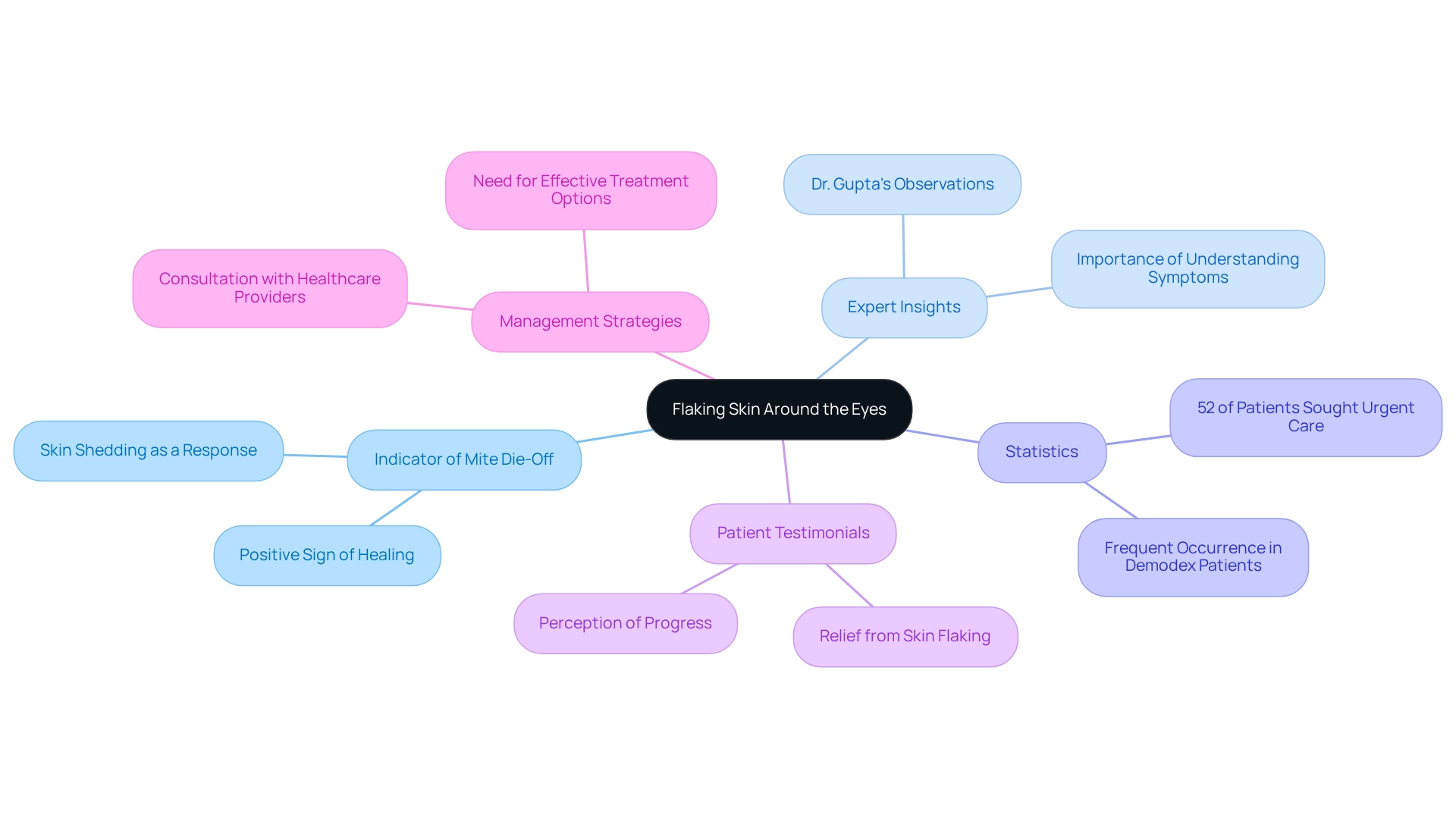
Decreased Redness and Inflammation: Signs of Mite Decline
Many individuals notice a significant reduction in redness and swelling around the eyes as the signs demodex mites are dying become apparent. We understand that this improvement can be a relief, as it reflects the effectiveness of care methods aimed at eliminating the mites. This leads to a calmer and healthier appearance of the skin. Clinical studies show that patients often report considerable reductions in redness and inflammation, with numerous individuals experiencing enhanced eye conditions after treatment.
Observing these positive changes is vital. It allows you to evaluate your progress and the effectiveness of your care. Eye care specialists emphasize that reduced redness and inflammation are key indicators of the signs demodex mites are dying. This highlights the importance of regular assessments throughout the treatment process.
Understanding these signs can empower you to seek timely medical intervention. Remember, we are here to help you through this process, fostering a sense of control over .
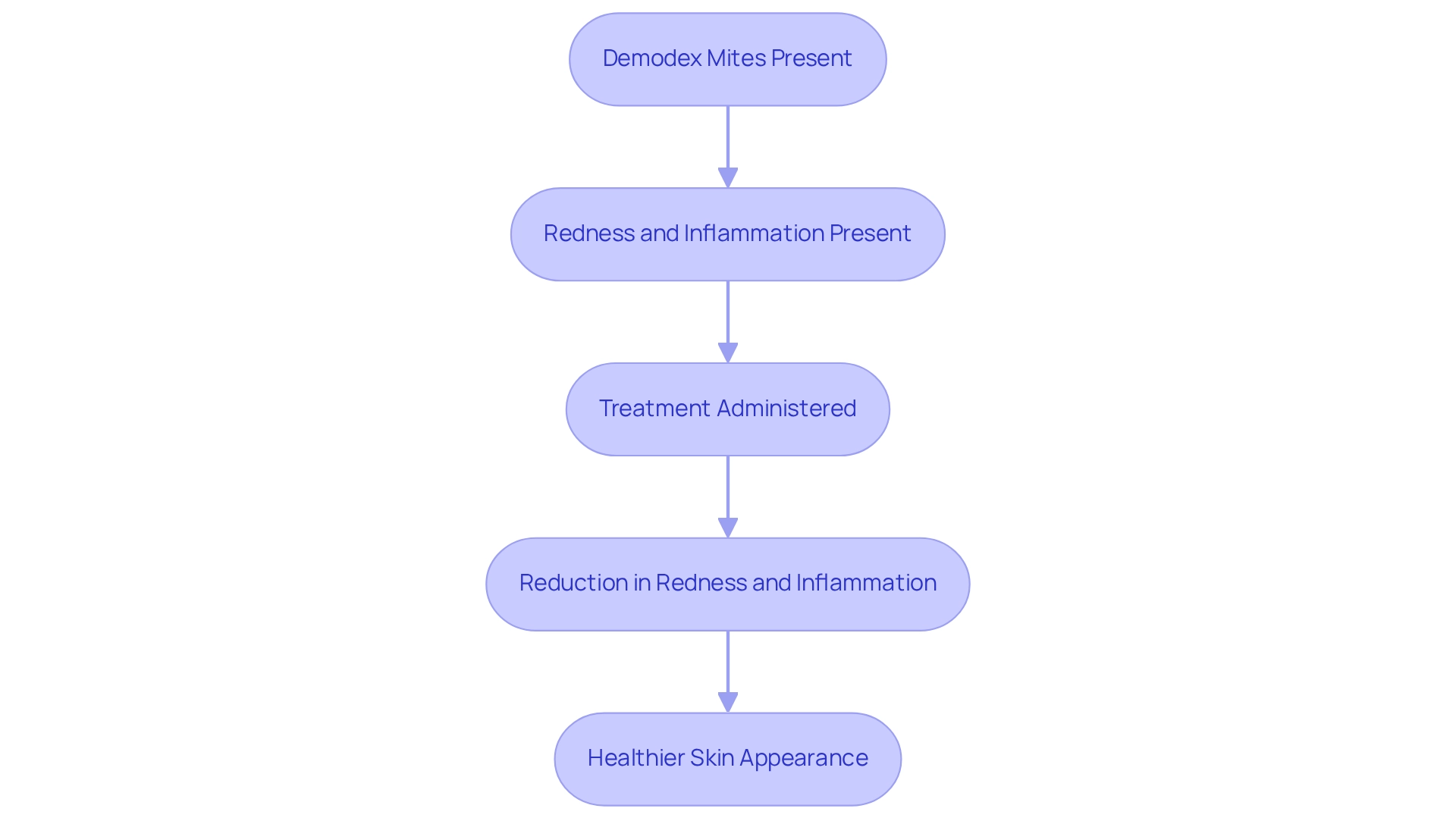
Improved Eyelid Hygiene: A Key to Reducing Mite Numbers
Maintaining optimal eyelid hygiene is crucial for effectively lowering populations, which are signs demodex mites are dying. We understand that dealing with these pests can be concerning, and consistently cleaning the eyelids with specialized products can help. This practice aids in removing the debris and oils that these pests flourish on. Including eyelid scrubs or wipes in your daily regimen not only supports your care initiatives but also plays an essential role in preventing future infestations.
Research shows that regular eyelid cleanliness can greatly reduce the presence of mites, and when effective practices are followed, there are signs demodex mites are dying, leading to marked enhancements in symptoms. In fact, 89.5% of control group participants rated the drop in symptoms as neutral to very comfortable. It’s common to feel overwhelmed, but ophthalmologists suggest creating a comprehensive eyelid care routine. This may involve:
- Gentle scrubbing methods
- The application of , especially in severe instances of blepharitis that may necessitate prescription options such as ivermectin.
By prioritizing eyelid cleanliness, you can take proactive measures toward managing mite infestations and identifying the signs demodex mites are dying, which will enhance your overall eye health. Remember, as Dr. Mark Holdbrook notes, “The small sample size of the present study, particularly at the last follow-up visit, can be considered a potential limitation,” reminding us of the importance of individualized care in eye health management. We are here to help you through this process.
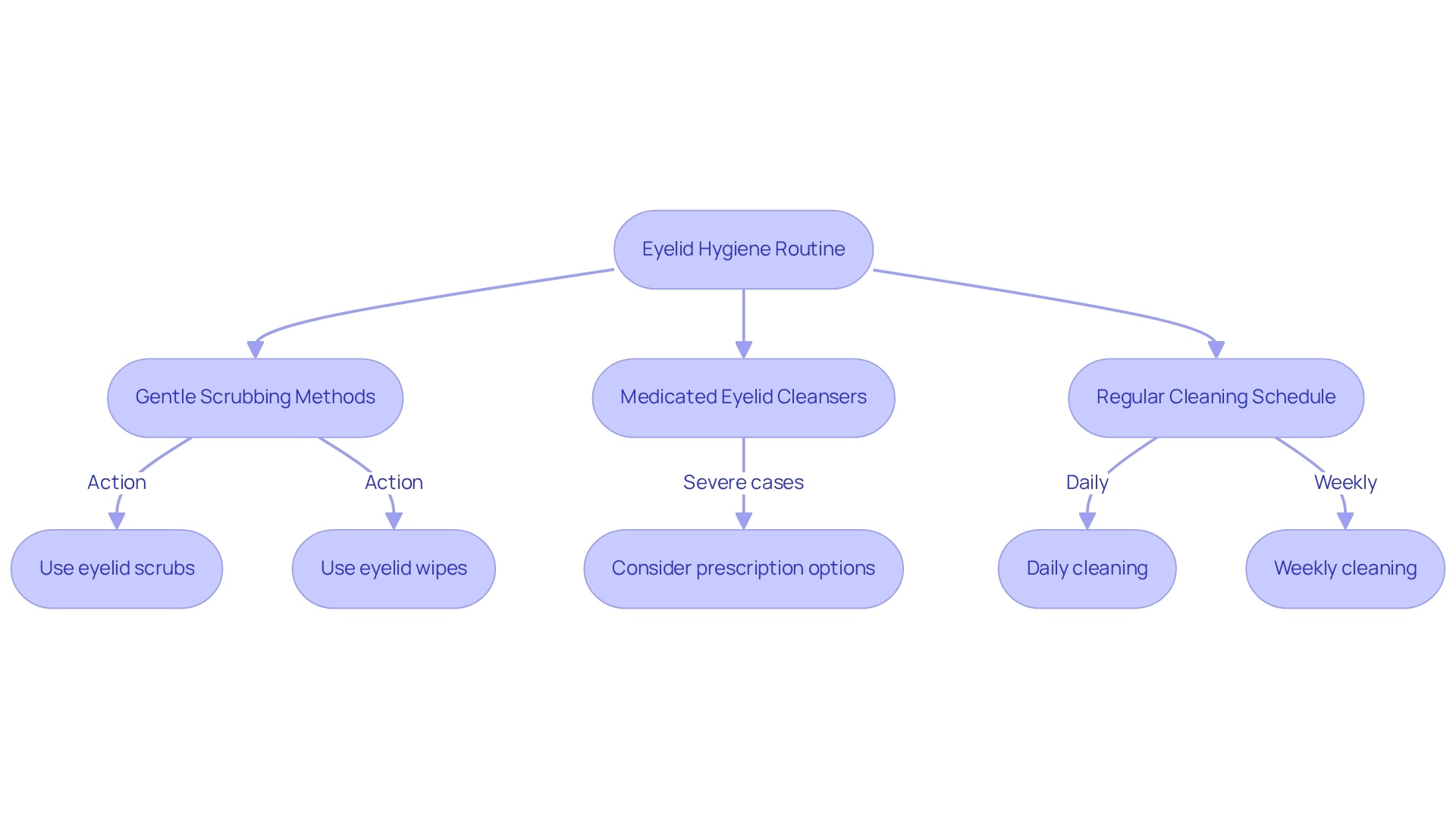
Effective Treatments: How They Contribute to Mite Die-Off
Managing Demodex infestations can feel overwhelming, but knowing the signs demodex mites are dying can help you find effective solutions. Topical medications and eyelid scrubs containing tea tree oil or other active ingredients specifically target these pests, providing signs demodex mites are dying while promoting their elimination and alleviating bothersome symptoms like itching and swelling. Many individuals have reported significant improvements in their condition after using tea tree oil, with research showing signs demodex mites are dying and a notable decrease in pest populations. For instance, examining a total of 12 lashes per eye provides clear evidence of the effectiveness of these methods.
We understand that customized care plans are crucial, especially since the and in those with weakened immune systems. A study on chronic blepharitis highlighted a higher prevalence of mites in affected patients, reinforcing the need for targeted strategies to address this issue effectively. These findings support the notion that mites play a significant role in chronic blepharitis, underscoring the importance of tailored care strategies.
Topical medications, particularly those with anti-parasitic properties, have shown promising results in clinical settings, which include signs demodex mites are dying. Patient satisfaction rates with these procedures are notably high, especially when combined with proper eyelid hygiene practices. Consulting with a healthcare provider is essential for identifying the most appropriate treatment plan that meets your personal needs, ensuring optimal results in managing mite infestations. As Ilaria Trave points out, individuals with rosacea experienced a higher frequency of positive outcomes in both microscopic examinations and PCR tests compared to controls, further emphasizing the importance of personalized care.
Remember, we are here to help you through this process, and it’s common to have questions and concerns. Your journey towards relief is important, and we encourage you to seek the support you need.
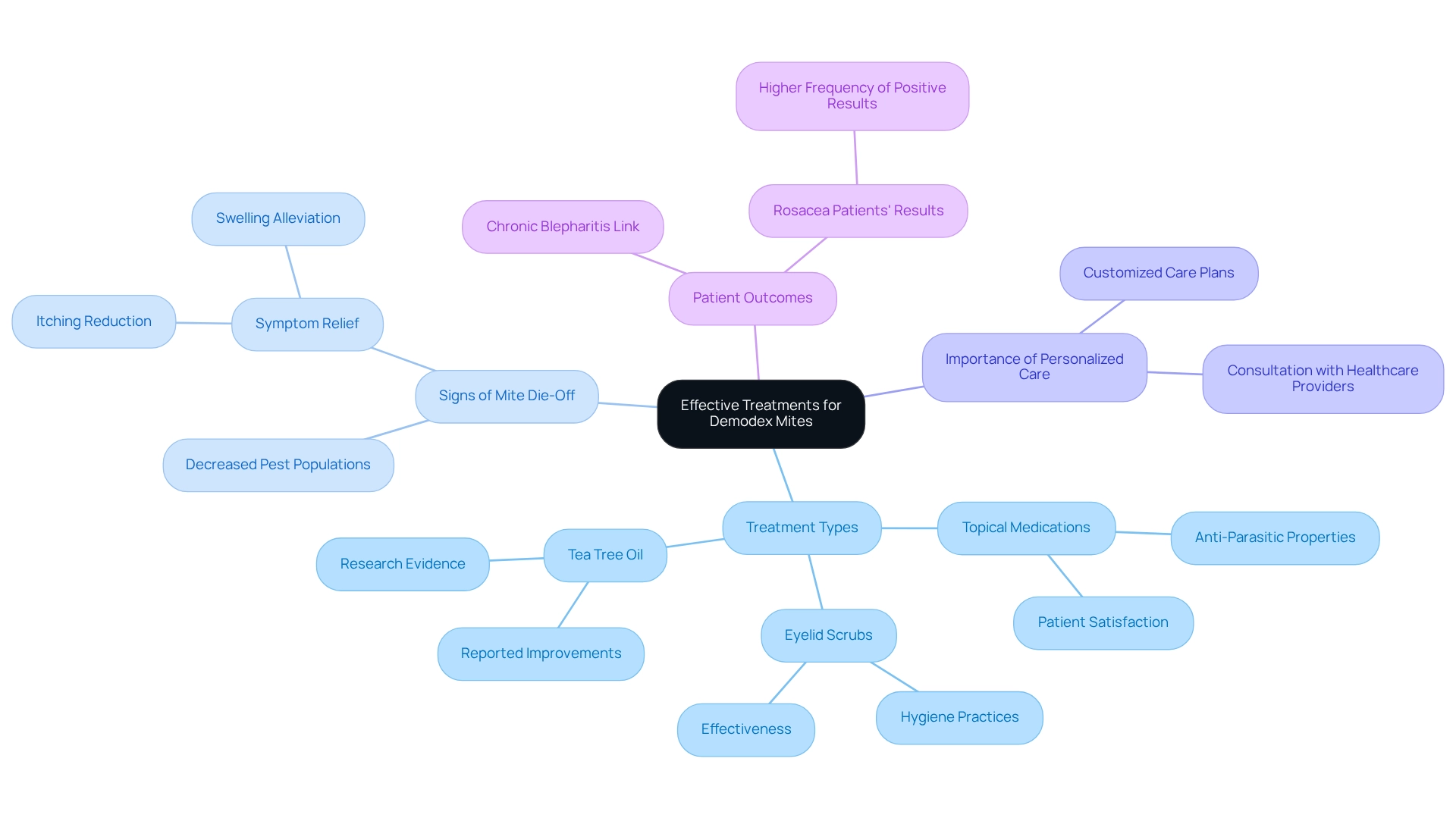
Enhanced Skin Health: Correlation with Mite Population Decline
As the number of Demodex organisms decreases, many patients notice signs demodex mites are dying along with a significant improvement in their skin health. It’s common to experience enhancements in skin texture, reduced irritation, and fewer breakouts when there are signs demodex mites are dying. This positive change not only boosts confidence but also serves as signs demodex mites are dying, indicating the effectiveness of the treatment regimen being followed.
We understand that each individual’s experience is unique. According to the case study titled “,” individuals with varying immune reactions to these organisms may experience different degrees of skin improvement. This highlights the intricate connection between parasite colonization and skin conditions.
Moreover, statistics show that a greater frequency of examinations is linked to higher detection rates of pest infestations. This emphasizes the significance of proactive management in your journey towards better skin health. As individuals observe the signs demodex mites are dying, many share an increasing feeling of optimism and contentment.
For instance, Elske shared, “Thank you for this information and your other nice blogs! It is very valuable to understand more about rosacea because it gives more understanding, more hope that I can heal from rosacea.” This strengthens the idea that effective mite management can lead to enduring skin health enhancements, ultimately aiding in overall comfort and well-being for individuals, including those with cataracts.
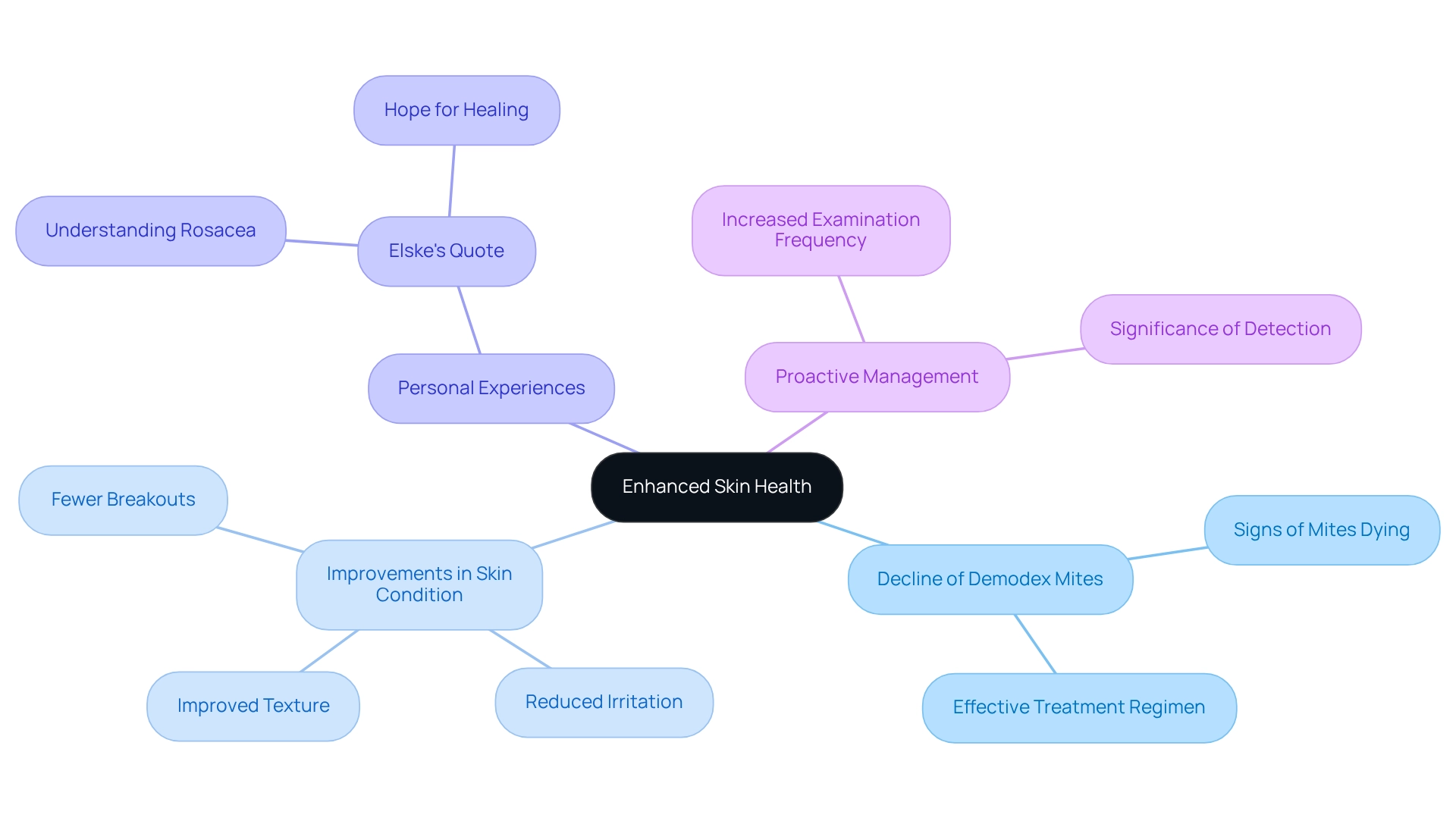
Reduced Anxiety: A Psychological Benefit of Mite Management
Effectively addressing mite infestations can greatly reduce anxiety for many individuals. As symptoms diminish and skin health improves, people often experience a boost in confidence, leading to less self-consciousness about their appearance. This psychological boost is essential; it improves overall quality of life and encourages individuals to follow their care plans and seek ongoing support.
We understand that tackling skin issues can lead to significant enhancements in mental health. Many individuals note reduced anxiety levels after effective care. Mental health professionals emphasize the importance of treating such infestations, pointing out that effective management can alleviate the psychosocial burdens associated with visible skin issues. Julie Gould states, “Treatments that safely and effectively address blepharitis and are easy to use are needed to alleviate the symptom burden and lessen psychosocial effects of blepharitis.”
Case studies show that individuals who actively participate in their care for skin mites frequently report a significant reduction in anxiety. This highlights the deep link between skin health and mental well-being. In this context, dedicating ourselves to controlling mites not only promotes better skin health but also nurtures a more positive mental state. It emphasizes the significance of thorough care in eye health.
Moreover, it is significant that merely 3% of individuals had undergone any in-office device procedure for their blepharitis condition. This underscores the importance of pursuing . We are here to help you through this process, ensuring you find the right care for your needs.

Symptom Monitoring: Tracking the Decline of Demodex Mites
is essential during the management of Demodex infestations to observe the signs demodex mites are dying. We understand that dealing with these symptoms can be challenging, which is why we encourage patients to maintain a detailed journal documenting changes in irritation, redness, and skin texture. This practice not only assists healthcare providers in assessing the efficacy of care but also improves communication between individuals and their support teams. By monitoring these symptoms, prompt modifications to the care strategy can be implemented, which may reveal signs demodex mites are dying and enhance outcomes for you.
Research shows that individuals frequently perceive their symptoms as more troubling than the simple presence of mites. A Delphi panel of specialists observed that 9 members concurred on this matter, underscoring the need for effective symptom management. The panel has acknowledged the significance of symptom monitoring, with plans for additional discussions centered on options for managing Demodex blepharitis (DB). This commitment to advancing knowledge reflects a growing understanding of the condition and its management.
Patient journals serve as valuable tools in this process, allowing you to document your experiences and track fluctuations in symptoms over time. Data indicate that following symptom tracking greatly improves therapeutic effectiveness, as it enables you to take an active role in your care. Healthcare providers emphasize that consistent monitoring can lead to better management strategies and improved patient satisfaction.
Moreover, a case study named “Future Directions for Blepharitis Research” emphasizes persistent inquiries concerning the care of DB and the necessity for additional exploration into effective management strategies. The DEPTH panel has observed a significant connection between rosacea and DB, emphasizing the complexity of managing symptoms associated with mite infestations, including signs demodex mites are dying.
In summary, symptom monitoring is not merely a passive task; it is a crucial element of effective treatment that encourages cooperation between you and healthcare professionals. Together, we can work towards improved health outcomes, ensuring that you feel supported every step of the way.
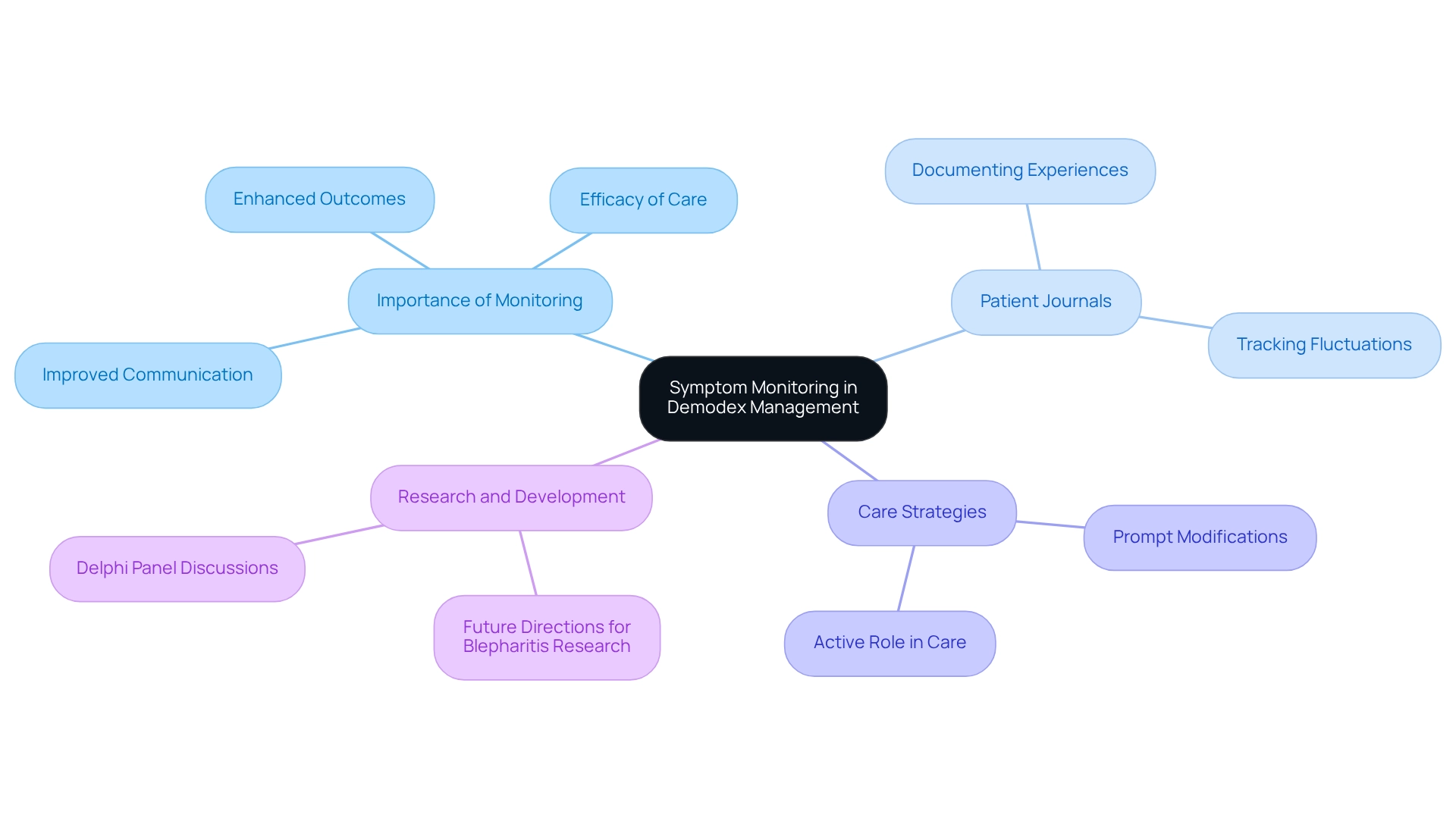
Patient Education: Understanding Demodex Mite Management
Patient education plays a vital role in managing infestations caused by these organisms. We understand that navigating these issues can be overwhelming, but gaining knowledge about them and their impact on eye health is essential. Studies indicate that of individuals seeking cataract surgery also experience blepharitis, underscoring the importance of addressing underlying issues like mites to improve surgical outcomes.
At Northwest Eye, we are dedicated to empowering individuals through comprehensive resources that explain the characteristics of Demodex mites, their symptoms, and the solutions available. By fostering a deeper understanding of these concerns, you can make informed choices regarding your care. Our clinic offers educational resources and support, ensuring you feel assured and informed throughout your care journey.
Experts emphasize that increasing patient awareness is crucial for achieving better clinical results. Informed patients are more likely to adhere to care protocols and recognize the importance of timely intervention. This proactive approach, which includes regular eye examinations and personalized treatment plans, not only helps manage Demodex infestations but also provides signs demodex mites are dying, enhancing overall eye health and highlighting the essential role of education in effective eye care.
Moreover, the underdiagnosis and misdiagnosis of blepharitis contribute significantly to the overall burden of illness. This makes accurate diagnosis and education even more critical. Remember, we are here to help you through this process, ensuring you receive the care and understanding you deserve.
Conclusion
The management of Demodex mites is essential for maintaining optimal eye health and preventing complications like blepharitis. We understand that symptoms associated with Demodex infestations—such as increased irritation, flaking skin, and reduced redness—can be concerning. Recognizing these symptoms is crucial as you navigate your treatment journey, empowering you to notice signs of mite die-off and evaluate the effectiveness of your care plans.
Effective treatments, including specialized eyelid hygiene practices and topical medications, play a significant role in reducing mite populations and improving overall skin health. The commitment of clinics like Northwest Eye to provide personalized care and patient education enhances treatment outcomes and fosters a proactive approach to eye health. As you learn to monitor your symptoms and maintain proper eyelid hygiene, you not only alleviate discomfort but also reduce anxiety associated with visible skin issues.
In conclusion, addressing Demodex infestations requires a comprehensive and informed approach. By prioritizing education, symptom monitoring, and effective treatment strategies, you can significantly improve your eye health and overall well-being. The journey towards managing Demodex mites is one that benefits greatly from collaboration between you and healthcare professionals, ultimately leading to healthier eyes and a renewed sense of confidence.
Frequently Asked Questions
What is Northwest Eye’s expertise in treating eye conditions related to Demodex?
Northwest Eye has over 50 years of experience in eye care, particularly in addressing issues related to Demodex mites and other skin parasites. Their skilled team provides advanced treatments and personalized care plans for patients.
What is the significance of timely intervention for blepharitis?
Timely intervention is crucial for managing blepharitis, as recent studies indicate that 10% of follow-up visits for this condition are directed to urgent care facilities, highlighting the need for effective management.
How does age affect the prevalence of blepharitis?
While age is not a significant predictor of blepharitis prevalence, the condition affects individuals across all age groups, indicating its widespread impact.
What symptoms do patients report when undergoing treatment for Demodex-related conditions?
Patients often report symptoms such as itching, redness, and irritation both at the time of diagnosis and following treatment, which highlights the effectiveness of the care provided at Northwest Eye.
What does increased eye irritation indicate during Demodex treatment?
Increased eye irritation can indicate that the immune system is responding to the dying Demodex mites, which may be a sign of effective reduction of the pest population, despite causing discomfort.
How common are Demodex mites in healthy individuals?
Studies show that Demodex mites are found in the eyelashes of about 18% of healthy individuals aged 21 to 35, highlighting the commonality of these organisms.
What other conditions can contribute to eye irritation during Demodex treatment?
Allergies and infections, such as conjunctivitis, dry eye disease, and keratoconus, can exacerbate sore, red, and itchy eyes during the treatment process.
What does flaking skin around the eyes signify in relation to Demodex treatment?
Flaking skin can be a sign that Demodex mites are dying, as it may result from irritation and inflammation due to the reduction of mite populations, indicating progress in the healing process.
How should patients interpret skin flaking around the eyes?
While skin flaking may be concerning, it often represents the body’s natural healing response and can be viewed as a positive sign of progress during Demodex management.
What should patients do if they experience symptoms during treatment?
Patients are encouraged to consult with their healthcare providers to discuss any symptoms they experience, ensuring they receive the best possible care and support throughout their treatment journey.






